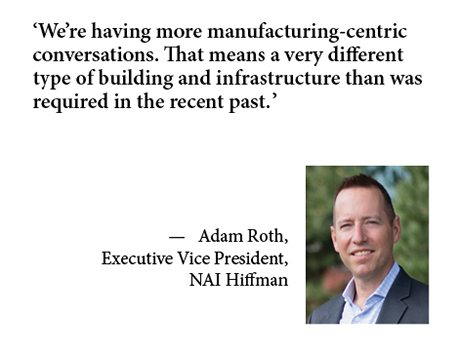Location’s importance to commercial real estate has become a cliché. But in logistics and industrial considerations, the idea is new again — it’s not about where you are but where customers need to go and the primacy of transportation. If you’re not at the place and time that clients need, it doesn’t matter how theoretically fine the setting or how impressive the facilities are.
“Transportation is roughly 12 times the cost of industrial real estate,” says Adam Roth, executive vice president at NAI Hiffman. Finished products, goods and materials are sent into and out of facilities over and over again. Shipping and trucking are a stiffly recurring expense and a much higher spend than real estate.
“If I can impact your transportation spend, the real estate is a much smaller factor in the supply chain. If you can address the current concern of transportation, real estate rates almost doesn’t matter, due to a location’s supply chain advantages. Real estate can be one of the best ways to combat transportation costs.”
The Rule of 1.5
In practical terms, customers’ plans for transportation are a series of changes, starting at factories, going to ports or warehouses for inventory, on to major and then minor distribution centers with possible secondary processing and ultimately to endpoints. It is where the transportation changes must take place that determines how commercial real estate will participate.
Complicating the picture is the need to plan in advance. After 10 years in logistics and 20 in commercial real estate, Roth has developed a concept he calls the Rule of 1.5. “I have found that transportation issues impact real estate 1.5 years later. In other words, the concerns specific to the supply chain sector today, will be addressed by industrial real estate over the next 18 months. Every year has a new wrinkle,” he says.
Industrial owners, operators and investors must anticipate where clients are moving and their needs at least a year and a half in advance to be prepared and able to maximize success.
The Rule of 1.5 explains, for example, why industrial became so hot in 2022. The COVID-19 pandemic shattered international supply chains. “A lot of corporations saw their product didn’t get to the continent and they missed they missed the holiday sales because store shelves were not properly stacked,” Roth says.
“The efficiency of an international supply chain is irrelevant if you missed those sales. So, in 2022, a ‘mandate’ for most of these companies came out: ‘We have to get everything on the continent that you can order, and we can’t miss a sale.’ So, the effect on industrial real estate was a frenzy for space to make up for the unreliability of production and transportation. Because getting more product on the continent and taking more warehouse space, all things considered, was a relatively inexpensive solution.”
The shift through 2022 and improvement of international supply chains set the stage for 2023, as trade entered more traditional patterns. Many people are surprised that industrial space is hitting the sublease market. “Companies are looking at their footprint saying, ‘We need to give some of this space back,’” notes Roth. But low vacancy will remain and there is an anticipated “drastic drop-off of speculative development” to occur in 2024.
Aiming to Meet the Future
To look ahead 1.5 years from now, to 2025, effectively, Roth says to pay attention to some key developments. Many companies are expanding supply chains and suppliers beyond China through “selective decoupling” to embrace multiple options, including reshoring manufacturing to the U.S. or “friendshoring” with like-minded nations to get closer to customers while reducing overreliance on any geographic area.
Supply chains will get shorter, with shorter lengths of haul. The term supply chain is starting to be replaced with supply web or international regionalization. In addition, some industries are increasingly being viewed as part of national security. “You’re seeing incentivization happen across the country, to promote better national control over some of those hard assets and some of those industries.”
These trends have combined to expand the idea of what location is and what it must contain for industrial properties. “We’re having more manufacturing-centric conversations,” Roth stresses. “That means a very different type of building and infrastructure than was required in the recent past. Power is a much more common topic of conversation. As another example, the major railroads had more focus on intermodal growth. Now they’ve refocused on direct-served opportunities — not only finished products from overseas but raw materials brought to a building utilizing a rail spur.”
To understand where to invest in industrial, Roth recommends considering different factors as overlays on a map that shows major and secondary roadways, access to population (consumers and labor), manufacturing components (power, water, rail), rail depots (intermodal) and ports as well as assessing the climate impacts of a region.
For example, climate change can adversely affect the movement of goods, but it can also impact the site selection of a long-term, high-cost manufacturing solution. Factory locations are increasingly important because as domestic production returns, nearby space will be needed to store manufacturing inventories. Locations of electrical substations and their capacities will only grow in importance as electrical power — needed for manufacturing and material handing — becomes essential to also power larger numbers of electric vehicles. Then there’s water availability and natural gas to consider.
“Obviously, none of this happens quickly,” says Roth. “But this is the direction I am confident the industrial real estate sector is traveling now. Risk is being assessed differently. The era of blind globalization based primarily on low-cost production is passing. Corporations are being forced to reduce their length of haul while improving their ability to react faster to the consumer. Stay tuned, we are inching towards the ultimate result of manufacturing on demand.”
This article was written in conjunction with NAI Global, a content partner of REBusinessOnline. For more articles from and news about NAI Global, click here.


